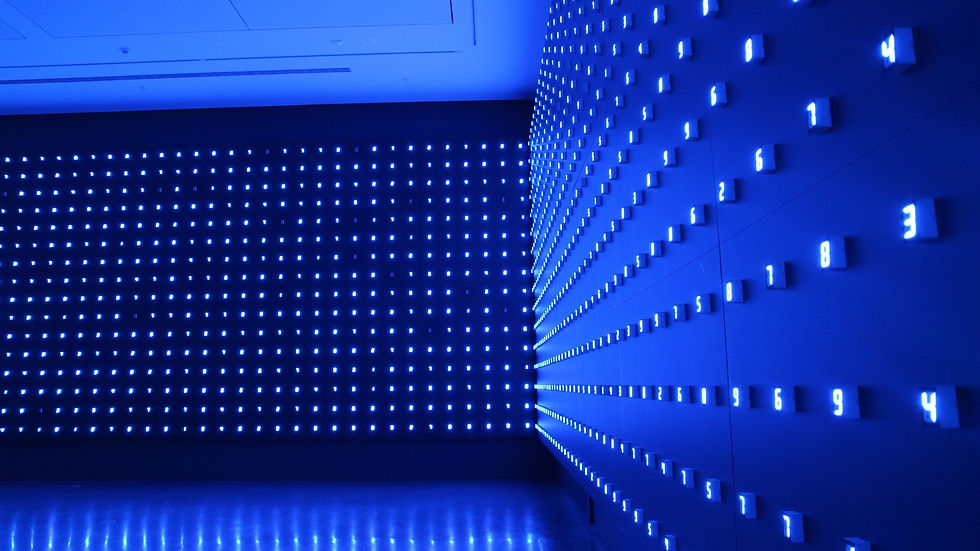Exhibition Review: Museum of Contemporary Art, Sydney
- Amelia Navascues
- Mar 1, 2017
- 4 min read
Tatsuo Miyajima Connects with Everything.
Over decades, technology has remained a central theme for internationally acclaimed artist, Tatsuo Miyajima. So, it’s no surprise that in his most recent show exhibiting at the Museum of Contemporary Art in Sydney, small, coloured neon diodes are the focus of visual interest.

The show is exhibiting the past forty years of the Japanese artist’s best works, and is called ‘Connect with Everything’. It’s a show which asks participants to immerse themselves completely in a series of room-based installations and sculptural works.
Conceptually, it considers how participants can reflect differently on questions of time, death and renewal in the digital age.
Removed entirely from the traditional aesthetics associated with naturalism, the world of Miyajima is a constellation of modern symbols; he namely finds himself using artificial hues generated by neon light and uses numbers which act more often like characters in his artworks.
Older pieces such as ‘Mega Death’ (1999-2016), a gridded and expansive wall of blue LEDs are included in the exhibit, whilst newer artworks like ‘The Arrow of Time (Unfinished Life)’ (2016) also make an appearance. The red LEDs featured in ‘The Arrow of Time (Unfinished Life)’ are a first for Miyajima, and show how colour can effectively generate a mood within a space.
Red, white, blue and green are the only tones used throughout the exhibition. An intentionally restricted range, Miyajima effectively toys with the limits the digital age may sometimes provide, by offering a colour spectrum known only to a modern world.

Inside the dimly lit rooms, glowing sculptures featuring the neon diodes, which are numbered, move in cyclic rounds from 0 to 9, repetitively. They flicker in a haunting discordant syncopated rhythm. It leaves you with a certain sense of unease as you enter, almost immediately, perhaps even seeking to represent time as mechanized cycle of constant and frenetic repetition.
But whilst offering initial contemplations akin to postmodernity, the ideas unifying many of the pieces in ‘Connect with Everything’ more often explore values associated with traditional Buddhist philosophy.
Upon entering the exhibit, a wall in the first room present these ideas. A long signature left by Miyajima himself explains the concept behind ‘Connect with Everything’. The translated text from Japanese to English covers the wall from top to bottom.
He says; ‘Everything is interacted with each other. Nothing could be independent. Therefore, art should be positively engaged with anything, and represents them in its own ways.’
Totalising as the concept may be, it’s this fluid value of connection, which hopes to stimulate new ways of thinking through art which is core to many of Miyajima’s artworks within the exhibition.
It shows how two seemingly disparate definitions of connection; one more literal, through technology, the other through people, might actually be more interconnected than previously thought. The concept itself sees a playful interaction, between art and technology existing through space. Miyajima’s use of colour and light also functions at a second, historical level, offering a broader narrative about the development of LED technology.
Whilst initially, earlier works by Miyajima only featured red and green diodes, blue LEDs later made their way into his artworks.
Interestingly, this blue diode was made possible in 1994 by a breakthrough from electronic engineer, Shuji Nakamura. Later finding himself working alongside Tatsuo Miyajima for the remainder of the 1990s through to today, diode technology soon became a creative watermark sustained throughout Miyajima’s art works.
Further, it became just one example accentuating the collaboration of the engineer/scientist and the artist as a prevailing creative and cultural norm today.
In addition to his use light and conceptual use of numbers, ‘Connect with Everything’ is an exhibition that also explores Buddhist philosophy and questions surrounding how time is valued.
In Buddhist philosophy, life and death are presented as a series of cycles. This concept of time runs counter to the more linear Western views, where death is perceived as an endpoint.
Miyajima’s most recent work ‘Mega Death’ (2016) is a historically reflective piece connected to this cyclical view of time. The artwork aims to commemorate all human tragedy inflicted in the 20th Century made by war or conflict.
But, despite the artworks’ somber undertones title, ‘Mega Death’ (2016) offers a less visceral representation than would be expected. Instead, the artwork is constructed by three, long walls of dotted twinkling blue lights, connected to a large open floor space offered for sitting and reflection.
In ‘Mega Death’ (2016), the use of numbers represents the energy and movement-like cycles of life and death. The diode-counters that cover the three walls also soak viewers in a mournful blue light, filling the room, as the numbers descend from 9-1 repetitively. Within ‘Mega Death (2016), the number 0 is not included within the counting cycle, but rather, is left blank. It’s a central component to the work, and referred to by Miyajima as the ‘9-1’ effect.
In the removal of the number 0, Miyajima offers philosophical solace to offer participants to see death less as an end to life, but more as a state of question or inquiry. The visual muting of the number ‘0’ and continuation of the 9-1 repetition therefore presents death, less as a negative abstraction, but more as a necessary component to renewal.
‘Connect with Everything’ is a powerful creative response chronicling from within the post-industrial information era. Miyajima’s effective array of blue, red, white and green LED light artworks present a candidly self-aware, and optimistic commentary of the modern day.
Shattering technology’s cold stereotyping as a barrier for connection, Miyajima’s ‘Connect with Everything’ is a powerful narrative of light, told in darkness offering ways we can resist less, connect more, with ideas that even may have the power to illuminate.








Comments